with solution and answers | Ray Optics | Physics - Book Back Numerical Problems | 12th Physics : UNIT 6 : Ray Optics
Chapter: 12th Physics : UNIT 6 : Ray Optics
Book Back Numerical Problems
Numerical Problems
1. An object of 4 cm height is placed at 6 cm in front of a concave mirror of radius of curvature 24 cm. Find the position, height, magnification and nature of the image.
[Ans: v=12 cm, h'=8 cm, m=2, image is erect, virtual, twice the height of object on right side of mirror.]
Given:
h
= 4 cm ; u = -6 cm, R = 24 cm, f = ?
v
=? h = ?, m = ?
Solution:
Focal
length f = R/2 = 24/2
F
= 12 cm
The
mirror equvation, 1/f = 1/v + 1/u
1/
-12 = 1/v + 1/-6
1/v = 1/6 – 1/12 = 1/12
∴ v = 12 cm
Magnification
(m) = h’/h = - v/u
h’ = h (
-v /u ) = 4 ( -12/-6)
h’ =
8 cm
m
= h’ / h = 8/4 = 2
m
= 2
∴ Image is erect, virtual, twice the height of object on right side of mirror.
2. An object is placed in front of a concave mirror of focal length 20 cm. The image formed is three times the size of the object. Calculate two possible distances of the object from the mirror.
[Ans: with +m, u = –40/3 cm and with –m, u = –80/3 cm]
Data:
f = -20cm,
m = ±3,
Two
possible object distance (u) = ?
Solution:
If m = +3
The
magnification m = -v/u = 3
∴ v= -3u
The
mirror equation is
1/f = 1/v +1/u
-1/20
= 1/-3u + 1/u
-1/20
= 2/3u
3u = -40
u
= -40/3 cm
If m = -3
m = -v/u = -3
∴ v = 3u
∴ 1/f = 1/v + 1/u
-1/20
= 1/3u + 1/u
-1/20
= 4/3u
3u = -80
u = -80/3 cm (OR)
Alternate method:
If m = +3 :
m = f / f−u
3=
-20 / -20-u = 20 / 20+u
20+u = 20/3
u =20/3 − 20
= 20−60 / 3
∴ u = − 40/3 cm
If m= -3:
m= f / f−u
−3=
−20 / -20-u = 20 / 20+u
20
+ u = 20 / −3
20+u = 20/-3
u = (20/-3)
− 20
∴ u = − 80/3 cm
3. A beam of light consisting of red, green and blue is incident on a right-angled prism as shown in figure. The refractive index of the material of the prism for the above red, green and blue colours are 1.39, 1.44 and 1.47 respectively. What are the colours suffers total internal reflection?
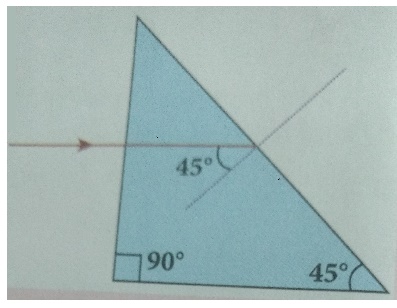
[Ans: green and blue suffer total internal reflection]
Given:
Angle
of incidence (i) = 45°
nR
= 1.39 ; nG = 1.44, nB = 1.47, ic =?
Solution:
Critical
angle (ic) = sin-1 (1/n)
For Red colour:
ic = sin -1(1/
1.39)
=
sin -1 (0.7194)
ic = 460
i < ic
; ∴ It does not suffer total internal
reflection.
For Green colour:
ic = sin -1(1/
1.44)
=
sin -1 (0.6944)
ic = 43.90
i < ic ; ∴ It suffer total internal reflection.
For Blue colour:
Ic = sin-1(1/1.47)
=
sin-1 (0.6803)
ic = 42.8°
i > ic ; ∴
It
suffer total internal reflection.
4. An object is placed at a certain distance from a convex lens of focal length 20 cm. Find the distance of the object if the image obtained is magnified 4 times.
[Ans: –15 cm.]
Data:
f = 20cm, m
= 4, u = ?
Solution:
m = v/u
= 4
v = 4u
The
lens equation is
1/f =
1/v − 1/u
1/f = 1/4u − 1/u
1/f = -3/4u
u = -3f / 4 = − 3 x20 / 4
u = − 15 cm
Alternate method:
m = f /
f+u
4
= 20 / (20+u)
20+u = 20/4 = 5
u = −15cm
5. Obtain the lens maker's
formula for a lens of refractive index n2 which is separating two
media of refractive indices ni and n3 on the left and
right respectively.
Solution:
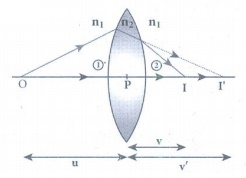
The
general equation for the refraction at a spherical surface is
[n2 / v] − [n1
/ u] = (n2 − n1) / R
For
left side, the light goes from n1 to n2
(n2 / v’ ) – (n1 /u) = (n2 − n1)
/ R1 --------------------(1)
For
right side, the light goes from n2 to n3.
I' acts as
virtual object.
n3 / v – n2/v’ = ( n3 − n2 )/
R2 -----------(2)
Adding
the equation (1) and (2), we get
[n3 /v] – [n1/u] = [(n2- n1)
/ R1 ] + [(n3-n2)
/ R2]
6. A thin converging glass lens made of glass with refractive index 1.5 has a power of + 5.0 D. When this lens is immersed in a liquid of refractive index n, it acts as a divergent lens of focal length 100 cm. What must be the value of n?
[Ans: 5/3]
Given:
n2
= 1.5 ; P = +5.0 D
n
(or) n1 = refractive index of liquid = ?
f
= 100 cm
Solution:
The
lens maker's formula:

Before
immerse in liquid
P=1/f
= 5D
n2=1.5
n1=1

After
immersed in liquid
f
= −100 cm = −1 m (diverging lens)
1/f
= − 1 D
n2=1.5
n1=
n

7. If the distance D between an object and screen is greater than 4 times the focal length of a convex lens, then there are two positions of the lens for which images are formed on the screen. This method is called conjugate foci method. If d is the distance between the two positions of the lens, obtain the equation for focal length of the convex lens.
[Ans: ( f = [D2 −d2] / 4D )
The
method is called conjugate foci (or) Bessel's method.
Solution:

Consider
only one position, object distance = - u;
Image
distance (v) = D − u
From
lens equation
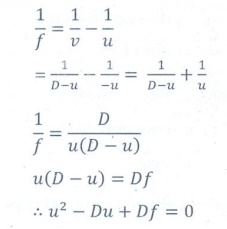
The
solution for the quadratic equation is

∴ Two possible positions of lens
from the object is

Distance
between the two position is
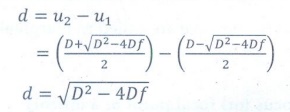
Squaring
and rearrange the above equation, we get
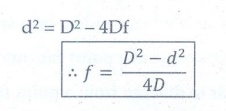
8. Prove that a convex mirror can only form a virtual, erect and diminished image.
Solution:
Image formation due to a convex mirror is
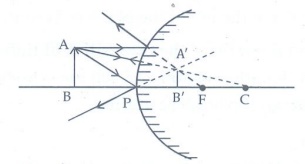
The
object placed any where on the principal axis. The convex mirror can only form
a virtual, erect and diminished image.
9. A point object is placed at 20 cm from a thin plano-convex lens of focal length 15 cm whose plane surface is silvered. Locate the position and nature of the final image.
[Ans: v = − 12 cm]
Given:
u
= -20 cm ; fl =15 cm ; v =
?
Solution:

The
power P of the silvered lens is
P
= 2Pi + Pm
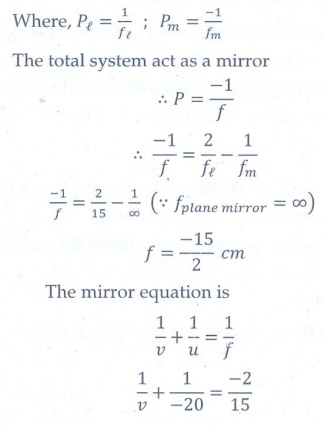
The
mirror equation is
1/v + 1/u = 1/f
(1/v) + (1/-20) = −2/15
1/v = (1/20) – (2/15)
∴ v = −12 cm
The
negative sign indicates that the image is formed to the left of the plano
convex mirror.
10. Find the ratio of the intensities of lights with wavelengths 500 nm and 300 nm which undergo Rayleigh scattering.
[Ans: 81:625]
Given:
λ1
= 500 nm ; λ2 = 300 nm,
I1 : I2 = ?
Solution:
According
to Rayleigh scattering law
1∝ 1/λ4
∴ The ratio of intensities of
light

Related Topics